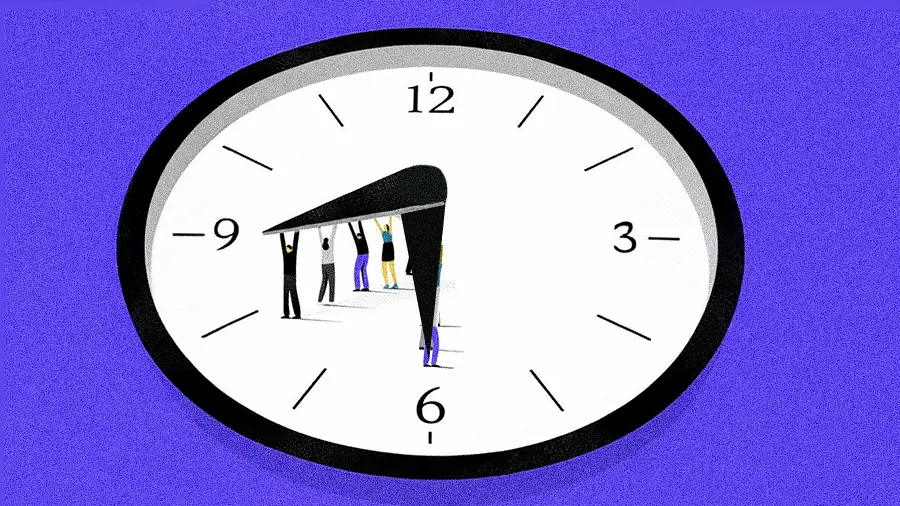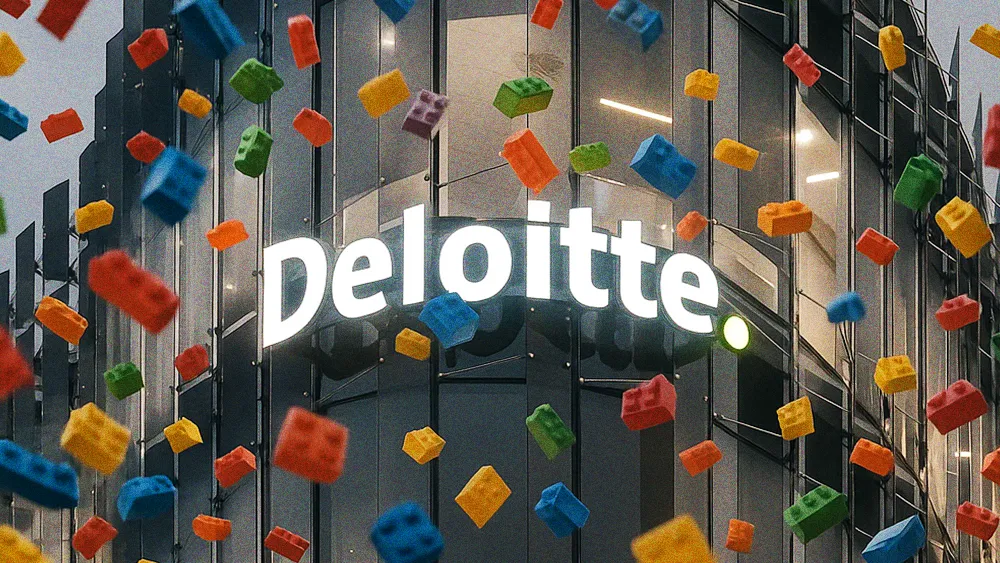Is the “9-9-6” workday a sign of dedication or a step too far?

Key Points
The “9-9-6” work model (9 am to 9 pm, six days a week) is reigniting a debate around ambition, overwork, and contribution in flexible work environments.
Kate Kruizenga, an experienced Fractional Chief People Officer, explains why leaders get better results when they channel motivation instead of managing time.
She outlines a framework for modern work that lets leaders set “core collaboration hours” to protect personal time and create clarity for teams.
Kruizenga describes how a mission-driven culture, where intense effort is a byproduct of shared belief, is in direct contrast with a transactional one built on an equity gamble, or “hoped-for money.”
The more powerful way to inspire effort is how Tesla or SpaceX did it. They put in the extra cycles not because of a policy mandate, but because they genuinely believed in what they were building. As somebody who started in nonprofits, I believe you'll get far more from employees if they are driven by a mission, rather than gambling on a future unicorn.

Kate Kruizenga
Fractional Chief People Officer
Kate Kruizenga
The “9-9-6” work model (9 a.m. to 9 p.m., six days a week) is reigniting a debate around ambition and overwork. In many ways, the phenomenon is a symptom of wider workplace changes. As the adoption of AI and remote work creates new standards for defining value, the resulting ambiguity often leaves business leaders confused. Now, they face the challenge of measuring contribution when the traditional workday itself has become less clearly defined.
For an expert’s insight, we spoke with Kate Kruizenga, a Fractional Chief People Officer with over 15 years of experience building and transforming functions at startups and tech giants like Dropbox and Kaiser Permanente. Her take? Leaders achieve better results by channeling motivation instead of just managing time. The 996 trend is less about productivity and more about sociology, according to Kruizenga.
Hustle house: “This 9-9-6 trend is primarily seen in early-stage companies that foster a dorm room environment. For young professionals whose college experience was remote, they’ve recreated the formative, communal experiences they missed. The 996 schedule emerged from the act of living and working together, eventually becoming a way of managing inputs and a signal for the intensity and velocity at which that group wanted to move.” As companies mature, however, the demand for raw hours gives way to the need for the focused, efficient impact that experience provides.
The Slack-life balance: Forward-thinking workplaces are embracing the integration of work and life by designing flexible frameworks, Kruizenga explains. “As a caregiver, my work-life integration is actually excellent. I can bring Slack along to my son’s tutoring appointment and not be seen as a blocker to the team. A decade ago, as a parent, that might have been very hurtful and held my career back because I wouldn’t have had the ability to stay engaged while taking care of all sides of life.”
For Kruizenga, a key part of that approach involves creating clarity. “The challenge is having Slack open during family dinner. That’s why I encourage companies to establish core collaboration hours. You set the expectation with your team that during those core hours, we need to be omnipresent, and that outside those hours, there might be a lag.”
Money matters: Two very different approaches to motivation are emerging in the workplace, as a result, Kruizenga says. The first is a transactional, policy-driven approach built on a high-risk financial gamble. “In venture-backed startups, equity is the engine. The gamble is that if the company becomes worth $100 million and you own 1%, you’ve made a million dollars. But that ignores the reality of your equity diluting over time. Ultimately, you might not earn as much as you would at a late-stage company like Dropbox, where your $400,000 annual compensation is guaranteed. One is a sure thing. The other is hoped-for money.”
Mission over mandate: “The more powerful way to inspire that effort is how Tesla or SpaceX did it. That culture was driven by a belief in the mission because people wanted to get to Mars. They put in the extra cycles not because of a policy mandate, but because they genuinely believed in what they were building,” she explains. “As somebody who started in nonprofits, I believe you’ll get far more from employees if they are driven by a mission and you share the wins with them, rather than if they’re just gambling on a future unicorn.”
The rise of AI introduced another wrinkle, Kruizenga says. By shifting focus from volume to value, its true potential is in changing the nature of work itself. Logically, that shift in focus should be followed by new standards for measuring visibility and hours logged. But it also creates a new problem for talent development. “Ultimately, AI should allow us to focus our hours on what matters most. For example, one of my clients has a product for investment banks that automates nearly 65% of the manual work a junior analyst once did. But there’s a whole conversation about how to ramp early-career professionals if the bots are now doing most of those entry-level tasks.”
Zoom out, and the 9-9-6 trend is symptomatic of the current economic climate. Identifying it as one of several signs of a change in the macroeconomic power balance, Kruizenga describes how a tight labor market might tempt some employers to ask for more. In such an environment, a mission-driven culture becomes less of a preference and more of a competitive necessity.
Employer economy: The current economy puts immense power in employers’ hands, Kruizenga says. “Some are viewing labor through what could be called an exploitive lens, where they can ask more of their employees in a time with fewer jobs or options. You see that with the big push towards return to office and cutting perks and benefits. In this context, 9-9-6 is just one piece of the puzzle.”
Ultimately, the challenge for many leaders is simply to restore clarity. According to Kruizenga, that means defining collaboration, protecting time for deep focus, and building a culture that balances flexibility with performance. While 9-9-6 fails as a universal mandate, it can still have a place as a personal choice for a specific season of life, she concludes. “I don’t think 9-9-6 is inherently bad. There is a time and a space in life where you might want to double down on your career, just as in another season you might double down on family or community. Early in my career at Teach For America, I put in a lot of hours, and it helped me grow. We shouldn’t villainize the choice for people who want to lean into it. It’s not right for everyone, but it can be right for a specific season.”
For young professionals whose college experience was remote, the 9-9-6 schedule emerged from the act of living and working together. Eventually, it became a way of managing inputs and a signal for the intensity and velocity at which that group wanted to move.

Kate Kruizenga
Fractional Chief People Officer
Kate Kruizenga
For young professionals whose college experience was remote, the 9-9-6 schedule emerged from the act of living and working together. Eventually, it became a way of managing inputs and a signal for the intensity and velocity at which that group wanted to move.

Kate Kruizenga
Fractional Chief People Officer
Kate Kruizenga
Related articles
TL;DR
The “9-9-6” work model (9 am to 9 pm, six days a week) is reigniting a debate around ambition, overwork, and contribution in flexible work environments.
Kate Kruizenga, an experienced Fractional Chief People Officer, explains why leaders get better results when they channel motivation instead of managing time.
She outlines a framework for modern work that lets leaders set “core collaboration hours” to protect personal time and create clarity for teams.
Kruizenga describes how a mission-driven culture, where intense effort is a byproduct of shared belief, is in direct contrast with a transactional one built on an equity gamble, or “hoped-for money.”

Kate Kruizenga
Kate Kruizenga
Fractional Chief People Officer

Fractional Chief People Officer
The “9-9-6” work model (9 a.m. to 9 p.m., six days a week) is reigniting a debate around ambition and overwork. In many ways, the phenomenon is a symptom of wider workplace changes. As the adoption of AI and remote work creates new standards for defining value, the resulting ambiguity often leaves business leaders confused. Now, they face the challenge of measuring contribution when the traditional workday itself has become less clearly defined.
For an expert’s insight, we spoke with Kate Kruizenga, a Fractional Chief People Officer with over 15 years of experience building and transforming functions at startups and tech giants like Dropbox and Kaiser Permanente. Her take? Leaders achieve better results by channeling motivation instead of just managing time. The 996 trend is less about productivity and more about sociology, according to Kruizenga.
Hustle house: “This 9-9-6 trend is primarily seen in early-stage companies that foster a dorm room environment. For young professionals whose college experience was remote, they’ve recreated the formative, communal experiences they missed. The 996 schedule emerged from the act of living and working together, eventually becoming a way of managing inputs and a signal for the intensity and velocity at which that group wanted to move.” As companies mature, however, the demand for raw hours gives way to the need for the focused, efficient impact that experience provides.
The Slack-life balance: Forward-thinking workplaces are embracing the integration of work and life by designing flexible frameworks, Kruizenga explains. “As a caregiver, my work-life integration is actually excellent. I can bring Slack along to my son’s tutoring appointment and not be seen as a blocker to the team. A decade ago, as a parent, that might have been very hurtful and held my career back because I wouldn’t have had the ability to stay engaged while taking care of all sides of life.”
For Kruizenga, a key part of that approach involves creating clarity. “The challenge is having Slack open during family dinner. That’s why I encourage companies to establish core collaboration hours. You set the expectation with your team that during those core hours, we need to be omnipresent, and that outside those hours, there might be a lag.”
Money matters: Two very different approaches to motivation are emerging in the workplace, as a result, Kruizenga says. The first is a transactional, policy-driven approach built on a high-risk financial gamble. “In venture-backed startups, equity is the engine. The gamble is that if the company becomes worth $100 million and you own 1%, you’ve made a million dollars. But that ignores the reality of your equity diluting over time. Ultimately, you might not earn as much as you would at a late-stage company like Dropbox, where your $400,000 annual compensation is guaranteed. One is a sure thing. The other is hoped-for money.”
Mission over mandate: “The more powerful way to inspire that effort is how Tesla or SpaceX did it. That culture was driven by a belief in the mission because people wanted to get to Mars. They put in the extra cycles not because of a policy mandate, but because they genuinely believed in what they were building,” she explains. “As somebody who started in nonprofits, I believe you’ll get far more from employees if they are driven by a mission and you share the wins with them, rather than if they’re just gambling on a future unicorn.”

Kate Kruizenga
Kate Kruizenga
Fractional Chief People Officer

Fractional Chief People Officer
The rise of AI introduced another wrinkle, Kruizenga says. By shifting focus from volume to value, its true potential is in changing the nature of work itself. Logically, that shift in focus should be followed by new standards for measuring visibility and hours logged. But it also creates a new problem for talent development. “Ultimately, AI should allow us to focus our hours on what matters most. For example, one of my clients has a product for investment banks that automates nearly 65% of the manual work a junior analyst once did. But there’s a whole conversation about how to ramp early-career professionals if the bots are now doing most of those entry-level tasks.”
Zoom out, and the 9-9-6 trend is symptomatic of the current economic climate. Identifying it as one of several signs of a change in the macroeconomic power balance, Kruizenga describes how a tight labor market might tempt some employers to ask for more. In such an environment, a mission-driven culture becomes less of a preference and more of a competitive necessity.
Employer economy: The current economy puts immense power in employers’ hands, Kruizenga says. “Some are viewing labor through what could be called an exploitive lens, where they can ask more of their employees in a time with fewer jobs or options. You see that with the big push towards return to office and cutting perks and benefits. In this context, 9-9-6 is just one piece of the puzzle.”
Ultimately, the challenge for many leaders is simply to restore clarity. According to Kruizenga, that means defining collaboration, protecting time for deep focus, and building a culture that balances flexibility with performance. While 9-9-6 fails as a universal mandate, it can still have a place as a personal choice for a specific season of life, she concludes. “I don’t think 9-9-6 is inherently bad. There is a time and a space in life where you might want to double down on your career, just as in another season you might double down on family or community. Early in my career at Teach For America, I put in a lot of hours, and it helped me grow. We shouldn’t villainize the choice for people who want to lean into it. It’s not right for everyone, but it can be right for a specific season.”




